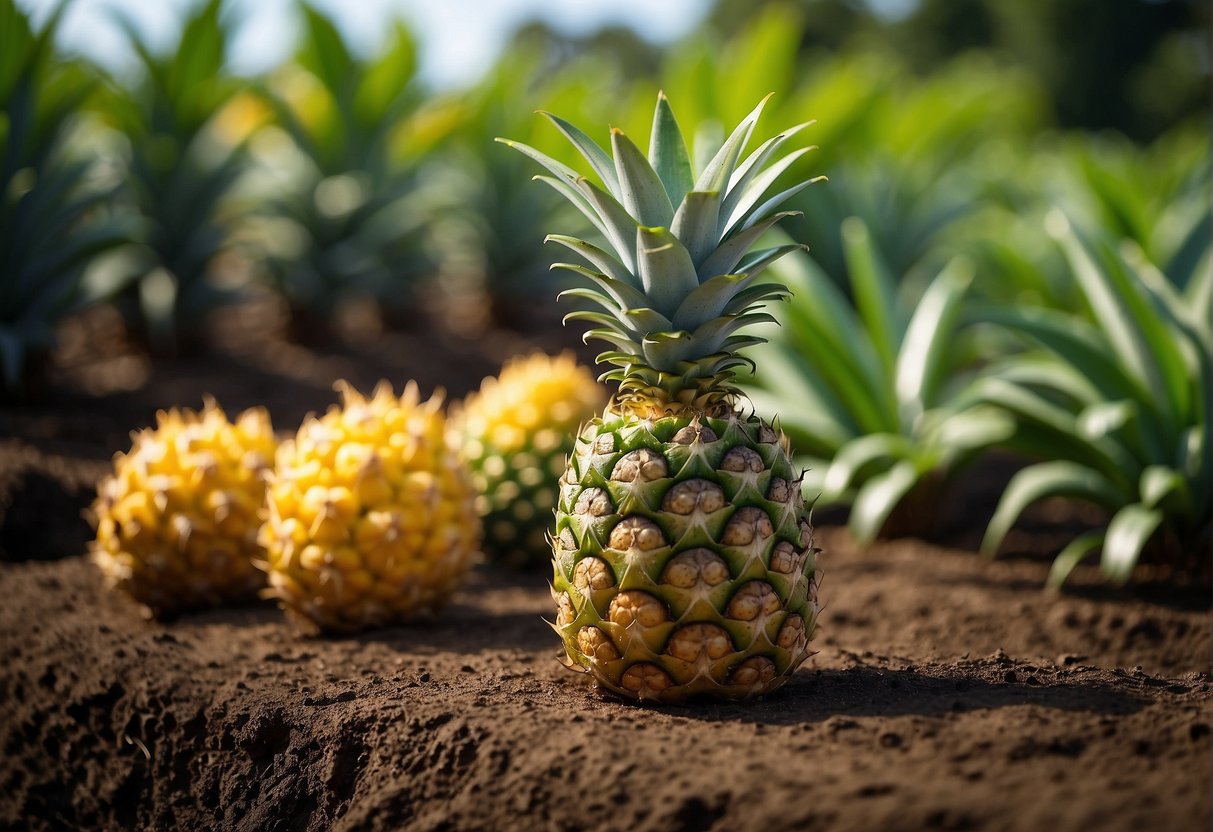Pineapple cultivation represents a fascinating journey into the world of tropical fruit farming, and fertilizer management is a cornerstone of successful pineapple growth. As a member of the Bromeliaceae family, the pineapple plant or Ananas comosus, requires careful attention to nutritional balance to thrive. Through my experience, I have learned that the key to a healthy and fruitful pineapple plant isn’t just about the quantity of fertilizer but about the quality and composition as well.

I’ve found that a balanced fertilizer with an NPK ratio of 6-6-6 or 10-10-10 is highly effective, particularly when applied at specific stages of the pineapple’s growth cycle. Solid fertilizers are usually applied around months two and four after planting, providing the essential nutrients that the plant needs to develop a strong foundation. In the later stages, specifically from the sixth month onwards, foliar fertilizers contribute to the pineapple’s development by supporting flowering and fruit production, delivering nutrients directly to the leaves.
Beyond synthetic fertilizers, I advocate for organic options such as well-decomposed manure or compost. These materials contribute to the soil’s health by improving its structure and fertility, creating an environment conducive for pineapple plants to absorb nutrients efficiently. My experience has also shown that organically fertilized pineapples tend to have an added layer of flavor complexity, possibly due to the richer soil biodiversity that organic matter promotes.
JUMP TO TOPIC
Soil and Water Requirements for Pineapple Plants
Proper soil composition and watering techniques are crucial to ensuring the growth and fruiting of pineapple plants. They require soil rich in nutrients with a slightly acidic pH and consistent moisture without becoming waterlogged.
Assessing Soil Fertility
💥 Key to Success: Assuring Nutrient-Rich Soil
The following table shows the ideal nutrient levels for pineapple plants:
| Nutrient | Level |
|---|---|
| Nitrogen (N) | Medium |
| Phosphorus (P) | Medium |
| Potassium (K) | High |
| pH Level | 4.5 – 6.5 |
Optimizing Watering Practices
I ensure my pineapple plants receive consistent moisture but avoid overwatering to prevent root rot. Pineapples thrive with about an inch of water per week, depending on the weather conditions. Potted pineapple plants may need more frequent watering due to the limited soil volume.
Fertilization Strategies for Healthy Growth
When I grow pineapple plants, I focus on precise fertilization to ensure their optimal growth and vibrant fruit production. Key to this is selecting the right type of fertilizer and applying it at times that best suit the developmental stage of the plant.
Choosing the Right Fertilizer
💥 Nutrient Needs:
🌱 Pineapple plants require a balanced blend of nitrogen (N), phosphorus (P), and potassium (K) for strong root development and fruit growth. A common recommendation is to use a granular NPK 6-6-6 or 10-10-10 fertilizer.
Homing in on Quality:
I opt for fertilizers that offer slow-release of nutrients, which provide a steady supply over time, minimizing the risk of nutrient burn and supporting continuous growth. Synthetic fertilizers are efficient and have precise NPK ratios, while organic options like well-decomposed manure improve soil structure and encourage beneficial microbial activity.
Application and Timing for Maximum Benefit
It’s critical to avoid direct contact of fertilizer with the pineapple leaves to prevent damage.
Timing is imperative: Since pineapples have an active growth period during the growing season, I fertilize young pineapple plants with 1 to 2 ounces of the chosen fertilizer every 8 weeks. As the plants mature, I gradually increase the amount.
Preventing and Managing Pineapple Plant Problems
When nurturing pineapple plants, ensuring the right balance of nutrients and vigilantly safeguarding against common diseases and pests are vital steps. Over-fertilization can be as detrimental as nutrient deficiency, so I strive to find that perfect equilibrium to keep my plants thriving. I monitor soil pH and nutrient levels carefully to avoid potential issues.
Controlling Diseases and Pests
Pineapple plants are susceptible to a variety of diseases and pests that can be detrimental to their health and productivity. I use a combination of preventative and treatment measures to control these challenges:
-
Regular inspection: I always keep an eye out for telltale signs of pest infestations like chewed leaves or the presence of insects themselves, and for symptoms of diseases such as yellow leaves or unusual spotting.
-
Integrated Pest Management (IPM): I prefer using natural predators or barriers to reduce pest populations rather than reaching for chemicals immediately.
-
Hygiene: I remove any diseased plant material promptly and disinfect my tools to prevent the spread of pathogens.
-
Balanced nutrition: By providing the correct ratio of nutrients, including micronutrients such as iron, magnesium, calcium, and zinc, I help strengthen the plants’ natural defenses against diseases and pests.
Mitigating Issues with Over-fertilization
To avoid the negative impact of over-fertilization on pineapple plants:
-
Moderation: I follow recommended fertilizer application rates to ensure plants receive their nutritional needs without excess.
-
Timely applications: I time the fertilizer applications to match the growth stages of the plant when the uptake of nutrients is at its peak.
-
Soil testing: I periodically test the soil to monitor nutrient levels and adjust fertilization accordingly, preventing the buildup of nutrients like nitrogen which can lead to root rot or the scorching of leaves.
By doing all of this, I work towards effectively managing my pineapple plants’ health, curbing potential problems before they become severe.












